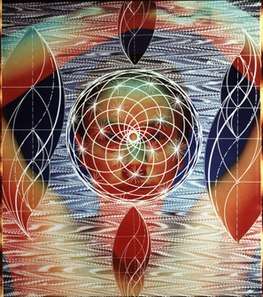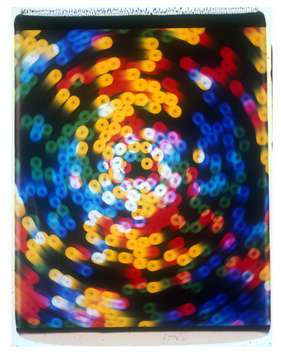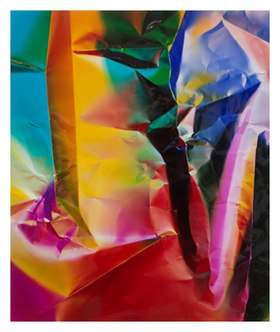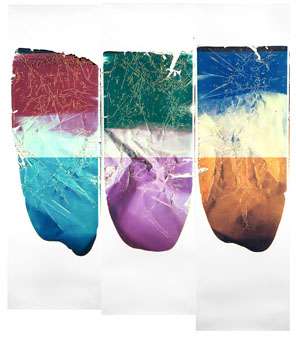Ellen Carey
Ellen Carey (born 1952) is an American artist known for conceptual photography exploring non-traditional approaches to light involving process, exposure, and paper that overturn the photograph's conventional status as an iconic "sign" or reproduction of a physical object.[1][2][3] Her work has ranged from painted and multiple-exposure, Polaroid 20 x 24, Neo-Geo self-portraits beginning in the late 1970s to cameraless, abstract photograms and minimal Polaroid images from the 1990s onward, which critics often compare to color-field painting.[4][5][6] Carey's sixty one-person exhibitions have been presented at museums, such as the Amon Carter Museum of American Art, [7] International Center of Photography (ICP)[4] and Wadsworth Atheneum Museum of Art,[8] alternative spaces such as Hallwalls[9] and Real Art Ways,[10] and many commercial galleries.[11] Her work is in numerous museum collections, including those of the Metropolitan Museum of Art,[12] Whitney Museum of American Art,[13] Los Angeles County Museum of Art,[14] Centre Pompidou,[15] and Smithsonian American Art Museum.[16] In 2019, she was named one of the Royal Photographic Society (London) "Hundred Heroines", recognizing leading women photographers worldwide.[17][18][11] Los Angeles Times critic Leah Ollman describes her photography as "inventive, physically involving, process-oriented work" and her recent photograms as "performative sculptures enacted in the gestational space of the darkroom" whose pure hues, shadows and color shifts deliver "optical buzz and conceptual bang."[1] New York Times critic William Zimmer wrote that her work "aspires to be nothing less than a reinvention, or at least a reconsideration, of the roots or the essence of photography."[2] In addition to her art career, Carey has also been a longtime educator at the Hartford Art School and a writer and researcher on the history of photography.[19][20][21]
Ellen Carey | |
|---|---|
| Born | 1952 New York City, New York, United States |
| Nationality | American |
| Education | State University of New York at Buffalo, Kansas City Art Institute |
| Known for | Photography, Conceptual art |
| Awards | National Endowment for the Arts, Polaroid Artists Support Program |
| Website | Ellen Carey |

Life and career
Carey was born in New York City in 1952.[22][11] She studied at the Art Students League of New York (1970) before attending the Kansas City Art Institute, where she earned a BFA in 1975.[11] She was part of a mid-1970s Buffalo avant-garde while in graduate school at the State University of New York at Buffalo (MFA, 1978), which included artists Cindy Sherman, Robert Longo and Charles Clough and spawned the alternative spaces Hallwalls and Center for Exploratory and Perceptual Arts (CEPA), each of which held exhibitions of her early painted self-portraits.[9][23][24] In 1979, after receiving a CAPS grant, she moved to New York City and rented a studio in Soho.[22] She was one of the first artists invited into the Polaroid Corporation's program to sponsor artists interested in exploring the potential of its "instant film"; the technology played a key role in her Neo-Geo, post-psychedelic self-portraits of the 1980s and her later "Photography Degree Zero" abstract work.[25][26][27]
During her first decade in New York, Carey was featured in prominent shows at PS1 ("The Altered Photograph," 1979), the New Museum, White Columns,[28] the Albright-Knox Art Gallery, the Bronx Museum of Art,[29] the São Paulo Biennale ("The Heroic Figure," traveling 1984-6), The Alternative Museum,[30] and ICP,[31] among others.[11] Her one-person exhibitions include a ten-year survey at ICP (1987),[4] and shows at the Center for Photography at Woodstock (1996), Real Art Ways (2000),[10] Museum of Contemporary Photography (2002), Wadsworth Atheneum Museum of Art (2004),[8] Lyman Allyn Art Museum (2006),[32] and the Amon Carter Museum (2018).[33] She is also included in the international traveling exhibit, "The Polaroid Project: At the Intersection of Art and Technology" (2017–20).[34] Since 1991, Carey has divided time between living and working in Hartford, Connecticut and New York City.[35]

Work
Critic and curator Lyle Rexer identifies Carey as among the "most committed experimental photographers” in the United States; her explorations span black-and-white self-portraits embellished with paint, psychedelic portraits and abstract works made with the Polaroid 20 x 24, and cameraless, abstract photograms.[36][37][38] She has experimented with the medium's chemical, light-related, color and material properties, often rejecting its documentary dimension and hierarchical relations of subject and object in favor of possibilities residing between painting and sculpture, realized through the manipulation of process and printing.[36][3] Her work references a wide-range of movements, including Op Art and Neo-Geo, Neo-Expressionism, Surrealism and Dada, Minimalism, Conceptual art, feminism and performance art.[4][30][39][40] Carey's art can be organized into three major categories: early self-portraits and portraits; abstract photograms she collectively titles, "Struck by Light"; and abstract, Polaroid-based works she titles, "Photography Degree Zero."
Early self-portraits and portraits (1976–1988)
In a review of Carey's 1987 survey at ICP, Art in America critic Stephen Westfall described her self-portraits and portraits as "vastly underrated" work that proposed a merging of human form with metaphysical energies, made visible on the photographs through painted marks, light pens, and superimposed psychedelic and geometric patterns.[4][41] Her early works were black-and-white, gender-specific images whose dramatic poses and lighting and expressive marks suggested emotional states of pain, vulnerability or self-assurance and organic, ritualistic scenarios.[4][42][23]
In 1984, she turned to brilliantly hued, multiple-exposure color images, made with one of only five existing Polaroid 20 × 24 cameras, which were cooler, androgynous, and more aesthetically seductive.[27][4][43] This work departed from traditional portraiture in no longer seeking to capture the character or identity of its subjects;[4][43] rather, Carey or others served as de-individualized stand-ins for the human spirit, seamlessly disappearing into and merging with Op Art and Pop patterns evoking technology, biology, consciousness, time, and perhaps artificial intelligence.[42][31][44][39] Critics such as Barry Schwabsky suggested that the specific qualities of the patterns opened interpretive possibilities and raised notions of the self, variously, as infinitely complex, unknowable, fractured, constructed from readymade cultural forms, or spiritually seeking.[43][27]

"Struck by Light": Photograms (1989– )
Carey began creating cameraless photograms in 1989, which specifically explored abstraction and conceptual issues at the basis of photography, through a process embracing chance, improvisation, and risk.[6][45][46] Photograms date back to the dawn of photography, in work by mid-19th-century artists Anna Atkins and William Henry Fox Talbot—and later, Man Ray—who placed botanical specimens, salt, silver or other objects onto light-sensitive paper to create "shadow" images.[40][35] Carey creates hers in total darkness using photosensitive paper, which she crumples, creases, obscures or filters and exposes to light, creating color, shadow and depth effects that record her actions (e.g., Color Theory, 1995).[37][1][47] She began with black-and–white photograms, before shifting to muted color images that New York Times reviews said exalted in new techniques as they moved further into abstraction toward "a kind of photographic minimalism."[2][6][48]
In 2000, she began producing brightly hued photograms whose series titles reflected the objects or materials she used to interrupt or strike the paper (e.g., "Push Pins," "Penlights") or referenced visual phenomena, such as afterimages ("Blinks").[49] Reviewers describe her color photograms as "hyper-saturated, jewel-toned abstraction"[37] suggesting light candies, paper diamonds or asymmetrical kaleidoscopes, in which color is the subject itself; [50][51] they compare their fluid soaks of color to the stain painting of Helen Frankenthaler and Morris Louis and the painterly, draped fabric of Frans Hals and John Singer Sargent.[1][46] Considering them conceptually, Leah Ollman wrote, "Throughout this body of work, the paper's surface does double duty as object and subject, material and image. The literal and the abstract merge."[1]
Carey's "Caesura" series (2016–18) features vertical breaks in color along central axes with fine, radiating vein-like fissures that she creates by creasing or accordion-folding the paper.[1] The "Dings & Shadows" series (2010– ) introduces greater compositional range with dense surfaces of wrinkles and crumples ("dings") occurring at all angles, which Carey draws out with a penlight to create shadow and depth; she has often exhibited them in installations of up to twenty panels.[3][1][49] Her "Zerograms" (2018) reflect elements of her parallel "Pulls" series, incorporating a stark, geometric void in their centers that suggests a new sense of illusory space.[46]

"Photography Degree Zero" (1996– )
"Photography Degree Zero"[52] comprises Carey's experimental, darkroom-less work using a large-format Polaroid 20 x 24 camera, which explores the possibilities of minimalist photography.[3][46][53] These images—made without reference to a subject—defy fundamental expectations of "picture taking" through an image-making technique that she discovered, which exploits random developing emulsion flows by pulling the film from the camera (the "Pulls" series) and interrupting the dye-transfer process; in other cases, she rolls back the film, creating multiple exposures ("Rollbacks"), or mixes incompatible emulsions or developer to manipulate the process.[54][55][56]
The resulting scroll-like, unframed panels feature conical loops or tongues of single colors plus black, white or gray (in panel groupings, multiple colors occur in a single work); they have introduced a unique form to the medium, the parabola.[5][54][33] Her early "Pulls" often used a subdued palette, as in the three installations, Mourning Wall (2000), Birthday Portrait (1997) and Family Portrait (1996), which expressed grief over family losses;[2][5][47] William Zimmer described the diverse textures of Mourning Wall's gray slabs as achieving the effect of relief sculpture.[2] Her later "Pulls" and related series often incorporate startling flares or "waterfalls" of bright, sometimes overlapping color against blazing white grounds.[45][32][38][33]
Critics suggest they recall the monochrome "swoops" of Ellsworth Kelly or the lozenges and plumes of color-field painters Morris Louis and Larry Poons.[5][54][45] In addition to presenting the positive Polaroid images, Carey is singular in also presenting the peeled-off negatives as works of equivalent artistic substance.[5][53] Reviewers describe these elemental positive and negative works—borne of life-changing loss and existential crisis for Carey—as an emptying out of the image in which the process itself becomes the subject seen in the final, immediate result.[3][57][47] Artforum's Barry Schwabsky wrote that unlike some abstract photography, this work "represents a real disruption of the assumed link between photographic image and referent."[5]
Recognition and collections
Carey's work is in the permanent collections of more than 60 photography and art museums, including the Metropolitan Museum of Art,[12] Whitney Museum of American Art,[13] Los Angeles County Museum of Art,[14] Centre Pompidou,[15] Art Institute of Chicago,[58] Smithsonian American Art Museum,[16] San Francisco Museum of Modern Art, Albright-Knox Art Gallery, and George Eastman Museum, as well as in many private collections.[11] Her work has also been included in several art historical books, including Light and Lens: Photography in the Digital Age (2018),[40] The Polaroid Project: At the Intersection of Art & Technology (2017),[34] The Polaroid Years: Instant Photography and Experimentation (2013),[25][59] The Edge of Vision: The Rise of Abstraction in Photography (2013),[36] Color: American Photography Transformed (2013),[60] A Century of Colour Photography: From the Autochrome to the Digital Age (2009),[61] and A History of Women Photographers (1994),[62] among others.[63][64][65]
In 2019, the Royal Photographic Society (London) named Carey one of its "Hundred Heroines" commemorating international women photographers.[66][17][67] Carey has also received awards from the Polaroid Artists Support Program (1983-8, 2002),[25] Connecticut Commission on the Arts (1998, 2001), New York State Federation for Artists (1986), Massachusetts Council on the Arts (1986), and National Endowment for the Arts (1984), among others.[11]
Research and academia
Carey has written about and researched art-related topics such as the history of photography (including the first women photographer, Anna Atkins), color theory, and tetrachromacy and its relation to gender.[68][11] She has published essays on Sol LeWitt ("Color Me Real," in Sol LeWitt: 100 Views),[20] Man Ray ("At Play with Man Ray" in Aperture, which focused on her discovery of Ray's “hidden” signature in the 1935 photograph Space Writings (Self-Portrait)),[21] and her own work (in The Polaroid Years and The Polaroid Project).[69][70] Her research also informed a traveling exhibition she curated, "Women in Colour: Anna Atkins, Color Photography & Those Struck by Light" (2017, 2019).[68]
Carey has taught photography at the Hartford Art School from 1985–2019. She has also taught at Bard College, the International Center for Photography, and Queens College, and been an artist-in-residence at Loughborough University in the United Kingdom.[19]
References
- Ollman, Leah. "Ellen Carey's photograms turn plain paper into a topographic head trip," Archived 2019-04-14 at the Wayback Machine Los Angeles Times, April 10, 2017. Retrieved June 13, 2019.
- Zimmer, William. "A Family Album of Empty Pictures," The New York Times, December 10, 2000. Retrieved June 13, 2019.
- Fleischer, Donna. "The Black Swans of Ellen Carey: Of Necessary Poetic Realities," Let There Be Light: The Black Swans of Ellen Carey, Willimantic, CT: Eastern Connecticut State University Akus Gallery, 2014.
- Westfall, Stephen. "Ellen Carey at ICP and Simon Cerigo," Art in America, November 1987, p. 181.
- Schwabsky, Barry. "Ellen Carey, Ricco/Maresca Gallery," Archived 2019-07-09 at the Wayback Machine Artforum, November 1998. Retrieved June 13, 2019.
- Hagen, Charles. "Art in Review, Ellen Carey," The New York Times, December 23, 1994. Retrieved June 13, 2019.
- Amon Carter Museum of American Art. Mirrors of Chance: Photograms by Ellen Carey Archived 2019-07-09 at the Wayback Machine, Fort Worth, TX: Amon Carter Museum of American Art, 2017. Retrieved June 13, 2019.
- Rosoff, Patricia. "A Fresh Look at the Mystery of Photography," Hartford Advocate, December 9, 2004.
- Kino, Carol. "Renaissance in an Industrial Shadow," The New York Times, May 2, 2012. Retrieved June 13, 2019.
- Rexer, Lyle. "Ellen Carey at Real Art Ways," Art in America, June 2001.
- Akus Gallery, Eastern Connecticut State University. "Biography," Let There Be Light: The Black Swans of Ellen Carey, Willimantic, CT: Eastern Connecticut State University Akus Gallery, 2014.
- Metropolitan Museum of Art. Untitled (Self-Portrait), 1987, Ellen Carey, Collection. Retrieved June 13, 2019.
- Whitney Museum of American Art. "Ellen Carey," Archived 2019-04-07 at the Wayback Machine Artists. Retrieved June 13, 2019.
- Los Angeles County Museum of Art. "Ellen Carey," Archived 2019-04-07 at the Wayback Machine Collections. Retrieved June 13, 2019.
- Centre Pompidou. "Ellen Carey," Archived 2017-03-20 at the Wayback Machine Artists. Retrieved June 13, 2019.
- Smithsonian American Art Museum. "Ellen Carey," Archived 2019-04-07 at the Wayback Machine Artists. Retrieved June 13, 2019.
- The Royal Photographic Society. "Ellen Carey," Archived 2019-07-09 at the Wayback Machine Hundred Heroines. Retrieved June 13, 2019.
- Andy Warhol Foundation for the Visual Arts. "Warhol Foundation Announces Spring 2017 Grant Recipients,". Retrieved June 13, 2019.
- Hartford Art School. Ellen Carey Archived 2019-07-09 at the Wayback Machine, Directory. Retrieved June 13, 2019.
- Carey, Ellen. "Color Me Real," in Sol LeWitt: 100 Views Archived 2016-02-23 at the Wayback Machine (Susan Cross, Denise Markonish eds.), New Haven, CT: Yale University Press, 2009. Retrieved June 13, 2019.
- Carey, Ellen. "At Play with Man Ray," Aperture, Fall 2011.
- Underexposed. "Ellen Carey," Archived 2019-07-09 at the Wayback Machine Retrieved June 13, 2019.
- Strickland, Carol. "Wish You Were There," Archived 2019-07-09 at the Wayback Machine Art in America, May 24, 2012. Retrieved June 13, 2019.
- Pesanti, Heather. Wish You Were Here: The Buffalo Avant-Garde in the 1970s Archived 2019-07-09 at the Wayback Machine, Buffalo, NY: Albright-Knox Art Gallery, 2012. Retrieved June 13, 2019.
- Lombino, Mary-Kay and Peter Buse. "The Polaroid Years: Instant Photography and Experimentation," New York: Prestel, 2013. Retrieved June 13, 2019.
- Keats, Jonathon. "This Dazzling Polaroid Exhibit Shows How Tech Companies Can Learn The Art Of Disruption From Artists," Archived 2019-07-09 at the Wayback Machine Forbes, Aug 31, 2017. Retrieved June 13, 2019.
- Griffin, Jonathan. "Ellen Carey/M+B, Los Angeles, USA," Archived 2019-07-09 at the Wayback Machine Frieze, March 2016. Retrieved June 13, 2019.
- Linker, Kate. "Public Vison/White Columns," Archived 2019-07-09 at the Wayback Machine Artforum, November 1982, p. 77–8. Retrieved June 13, 2019.
- Grundberg, Andy. "Artists' Works Are at the Center of the Action," The New York Times, October 3, 1982. Retrieved June 13, 2019.
- Aletti, Vince. "Choices," The Village Voice, December 8, 1987.
- Grundberg, Andy. "Photography," The New York Times, July 5, 1987. Retrieved June 13, 2019.
- Genocchio, Benjamin. "Feminist Artworks With an Edge," The New York Times, January 7, 2007. Retrieved June 13, 2019.
- Blay, Christopher. "Trio," Archived 2019-04-14 at the Wayback Machine Ft. Worth Weekly, January 24, 2018. Retrieved June 13, 2019.
- Ewing William A. and Barbara P. Hitchcock (eds.) The Polaroid Project: At the Intersection of Art & Technology, University of California Press, 2017. Retrieved June 13, 2019.
- Brown, Susan Rand. " Ellen Carey," Art New England Archived 2019-07-09 at the Wayback Machine, March - April 2017. Retrieved June 13, 2019.
- Rexer, Lyle. The Edge of Vision: The Rise of Abstraction in Photography Archived 2015-12-27 at the Wayback Machine, New York: Aperture, 2013. Retrieved June 13, 2019.
- Gotthardt, Alexxa. "10 Artworks to Collect at AIPAD," Archived 2019-07-09 at the Wayback Machine Artsy, April 8, 2016. Retrieved June 13, 2019.
- Kordic, Angie. " These Abstract Photographers Redefine Perception of the Real," Archived 2019-07-09 at the Wayback Machine Widewalls, May 22, 2016. Retrieved June 13, 2019.
- Hatt, Etienne. "The Unbearable Lightness. The 1980s," ArtPress, November 2, 2016.
- Hirsch, Robert. [Light and Lens: Photography in the Digital Age], Burlington, MA: Elsevier/Focal Press, 2018. Retrieved June 13, 2019.
- Zimmer, William. "'The Colt Four' of Hartford: From Guns to Brushes," The New York Times, July 12, 1992. Retrieved June 13, 2019.
- Caley, Shaun. "Ellen Carey, Art City," Flash Art, Summer 1986, p. 72.
- Schwabsky, Barry. "Ellen Carey at Art City," Artscribe, September/October 1986.
- Zimmer, William. https://www.nytimes.com/1989/04/30/nyregion/art-photographs-with-surprises.html?searchResultPosition=38 "Photographs With Surprises,"] The New York Times, April 30, 2000. Retrieved June 13, 2019.
- Baker, Kenneth. "Ellen Carey in Berkeley," Archived 2019-07-09 at the Wayback Machine San Francisco Chronicle, January 18, 2003. Retrieved June 13, 2019.
- Barcio, Phillip. "Ellen Carey and The World of Color in Photography," Archived 2019-07-09 at the Wayback Machine IdeelArt, August 15, 2018. Retrieved June 13, 2019.
- Armstrong, Bill. "Ellen Carey," Dear Dave, Spring 2015, p. 61–70.
- Grundberg, Andy. "Abstraction Returns to Haunt Photography," Archived 2019-07-09 at the Wayback Machine The New York Times, February 25, 1990. Retrieved June 13, 2019.
- Ellen Carey website. "Struck By Light," Archived 2019-07-21 at the Wayback Machine Artworks. Retrieved June 13, 2019.
- Furman, Anna. "Pushing the Outer Limits of Photography," New York Magazine, July 25, 2016. Retrieved June 13, 2019.
- Vasseur-Lamine, Leïla. "Mirrors of Chance," Archived 2019-07-09 at the Wayback Machine Wall International Magazine, December 15, 2018. Retrieved June 13, 2019.
- Ellen Carey website. "Photography Degree Zero: 1996 – 2019," Archived 2019-07-20 at the Wayback Machine Artworks. Retrieved June 13, 2019.
- Indrisek, Scott. "A Brief History of Polaroids in Art, from Ansel Adams to Andy Warhol (and Beyond)," Archived 2019-07-09 at the Wayback Machine Artsy, July 12, 2017. Retrieved June 13, 2019.
- Harrison, Helen A. "Anchoring Perception to the Reality of Experience," The New York Times, May 13, 2001. Retrieved June 13, 2019.
- Miller-Keller, Andrea. "Whitney Biennial Curators Interview," ArtForum, March 2000.
- Bryant, Eric. "The Indecisive Image," Archived 2019-07-09 at the Wayback Machine ARTnews, March 1, 2008. Retrieved June 13, 2019.
- Wang, Susan. "Ellen Carey," Archived 2019-07-09 at the Wayback Machine Widewalls, May 24, 2016. Retrieved June 13, 2019.
- Art Institute of Chicago. "Ellen Carey," Archived 2019-07-09 at the Wayback Machine Artists. Retrieved June 13, 2019.
- Langley, Edwina. "How the Polaroid Camera Seduced the Art World," AnOther, June 8, 2017.
- Rohrbach, John. Color: American Photography Transformed Austin, TX: University of Texas Press, 2013. Retrieved June 13, 2019.
- Roberts, Pamela. A Century of Colour Photography: From the Autochrome to the Digital Age Archived 2013-06-30 at the Wayback Machine, London: Carlton Books Ltd., 2009. Retrieved June 13, 2019.
- Rosenbloom, Naomi. A History of Women Photographers Archived 2015-12-22 at the Wayback Machine, New York: Abbeville Press, 1994. Retrieved June 13, 2019.
- Rosoff, Patricia. Innocent Eye: A Passionate Look at Contemporary Art, North Adams, MA: Tupelo Press, 2012. Retrieved June 13, 2019.
- Hitchcock, Barbara. The Polaroid Book: Selections from the Polaroid Collections of Photography, New York: Taschen, 2008. Retrieved June 13, 2019.
- Manning, Jack. "Books: Photographs In the Tradition of Goya," The New York Times, February 17, 1978. Retrieved June 13, 2019.
- The Royal Photographic Society. "Hundred Heroines: Celebrating Women in Photography Today," Archived 2018-12-21 at the Wayback Machine Hundred Heroines. Retrieved June 13, 2019.
- Dunne, Susan. " University of Hartford art professor named one of world’s best 100 photographers," Archived 2019-05-31 at the Wayback Machine Hartford Courant, January 23, 2019. Retrieved June 13, 2019.
- Feinstein, Jon. "Scholarly Exhibition Explores the Pioneering Role of Women Using Color in Photography," Archived 2019-07-09 at the Wayback Machine HAFNY.org (Humble Arts Foundation New Photography), 2017. Retrieved June 13, 2019.
- Carey, Ellen. "In Hamlet’s Shadow," in The Polaroid Years: Instant Photography and Experimentation by Mary-Kay Lombino and Peter Buse, New York: Prestel, 2013. Retrieved June 13, 2019.
- Carey, Ellen. "Photography Time Zero," in The Polaroid Project: At the Intersection of Art & Technology (William A. Ewing and Barbara P. Hitchcock eds.), University of California Press, 2017. Retrieved June 13, 2019.
External links
- Ellen Carey official website
- Ellen Carey interview on Museé
- Ellen Carey interview on Underexposed
- Ellen Carey interview on Polaroid Process